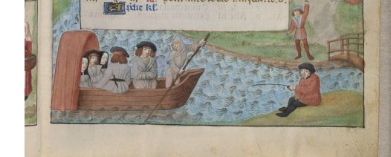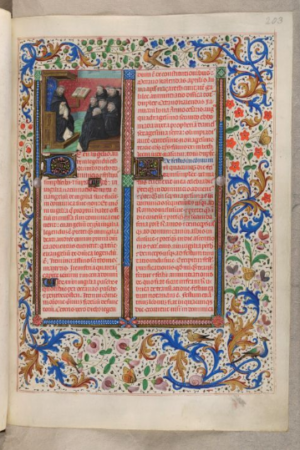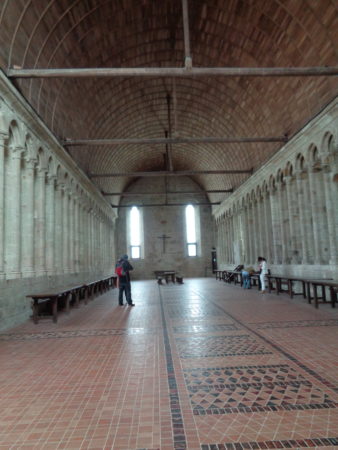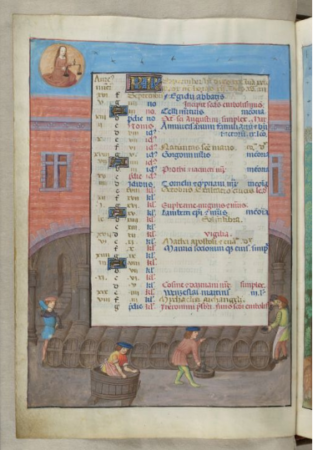Fish on Friday II: Monastic Meals
In the Middle Ages, fasting and Lenten traditions were highly evident
in the monastic houses. The different Rules and Orders (take your pick
from Benedictine, Carthusian, Cluniac, Cistercian, Premonstratensians,
Trinitarians, Beguines, and more!) had strict rules governing their
lifestyles, including their diet, nutrition, and meals.
Breviary of Queen Isabella of Castille, c. 1497, Taurus: Two Men Fishing, British Library MS 18851, f.3r.
Monastic communities ate their meals in the refectory, or dining room. In many communities the refectory, or frater, was on the south side of the cloister placing it relatively far away from the church and center of worship. Community meals were a key element in most of the religious rules, and especially important was the behavior at these meals. Before meal time, the brothers or sisters passed by the lavabo, or lavatory sink to wash their hands and any personal utensils. They proceeded to take a seat on long benches pushed up against the wall with trestle tables lining the room below the windows. In some orders, portions were collected at the refectory entrance and others dined family-style. Most orders ate in silence, with a lone reader sharing scripture to the community.

Breviary of Queen Isabella of Castille, c. 1497, A Dominican reading to his fellow brothers, British Library MS 18851, f. 203r.
There are a few exceptions which include meat in the refectory: the 8th century Rule of St. Chrodegang allows for two dishes per meal including one vegetable and one meat. These dishes should be shared among the brothers and when one ran out, the rest of the diners had to make do with the remaining option. This Rule also specifically mentions the recommended portions for bread (four pounds), cheese (one portion unspecified), wine, or beer (five gallons cumulatively; let’s hope these portions were for weekly rations otherwise those would be some pretty cheerful monks!).
The different orders allowed for a variety of diet; some orders only allowed one meal a day while others such as the Benedictines allowed two. Perhaps this is why there were a larger number of Benedictine houses compared to the other orders? The Rule of St. Columbanus is one of the strictest which restricts it to one frugal meal a day to honor a simple lifestyle and self-mortification. The diet was affected by the liturgical calendar too; during Lent the diet was even more frugal and around Easter it might be more bountiful.

The Romanesque refectory at Mont-St.-Michel, France. Photo by D. Trynoski, 2014.
Farm to Table
Monasteries produced much of their own food stock including fruit, vegetables, grain, fish, dairy products in limited quantities, beer, and wine. Most of the Rules called for a life of simplicity, humility, and poverty and this was manifest in the commitment to an agricultural lifestyle and simple meals. Some houses had a chapter of lay brothers, “monks lite,” who did not take formal monastic vows yet were affiliated with the house. Many of these lay brothers and sisters did the majority of the agricultural work and adapted some of the Rule’s lifestyle requirements. There were some houses in which the community performed the labor to more fully live according their house’s Rules.
Two of the most important roles in the monastic meal process were the Kitchener and the Cellarer. The Kitchener was the equivalent of a Head Chef, supervising food production and quality control, while the Cellarer was the General Manager, supervising supplies, stores, and product inventory. These two literally held the keys to the important stuff, and called the shots on what was served when. The Infirmerer played a secondary leadership role, since he or she needed to manage the accessibility to medicinal supplies, patient meals, and infirmary supplies. This person would be in close communication with the other two to ensure the production or acquisition of necessary supplies.
Many modern European vintners have their roots in a monastic vineyard (yes, that was intentional) and you can even visit monastic communities which still produce wine. Monastic wineries supply multiple markets including sacramental wine and the global wine industry. For some houses it is a major income source while for others it is merely a continuation of their medieval habits. Excessive drinking was discouraged in the medieval monastery, however it appears that moderate drinking of beer and wine was common. The Abbot and Abbess had discretion over the amount distributed; after a day of excessive labor he/she may allow for an extra tipple.

Breviary
of Queen Isabella of Castille, c. 1497, Libra: Men treading and
harvesting grapes, pouring wine out of barrels, British Library MS
18851, f. 5v.
Over time, the trend among Rules was a gradual laxity in the adherence to fasting and frugality. The early rules such as St. Augustine’s prioritized fasting as an essential part of pure monastic life, and over time the permitted diet increased to include fish, beer, wine, and then meat. First meat was allowed outside the refectory such as in the Abbot’s House, then it moved into the refectory on feast days, then during ecclesiastical seasons, then was included in the majority of monastic meals. As the monastic orders grew in size and the number of houses, their Rules flexed and changed. The evolution of monastic meals reflects the vibrant and active nature of medieval society, and represents the tangled relationships between religion and society.
Are you feeling hungry now? Wash your hands, get your nosh, and pray!
